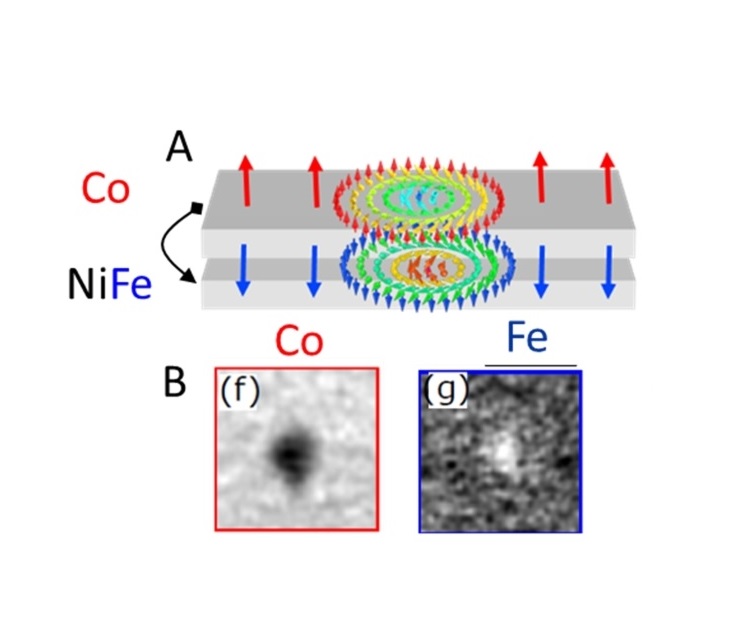Skyrmions in synthetic antiferromagnets are appealing for use in future memory and computing devices, combining small size and fast motion, but creating, stabilizing, and observing them remains a challenge. Here, we demonstrate the stabilization and current and light induced nucleation of skyrmions in a synthetic antiferromagnet, observing the magnetization texture in each layer using X-ray magnetic microscopy.
Magnetic skyrmions are currently fascinating many research groups in the world, as they could offer a new way to store and process information in our computers. These nanoscale magnetic textures are composed of elementary nanomagnets that wind up to form a stable spiral structure, like a well tighten node. Skyrmions can be manipulated by very low electrical currents, which opens a path for their use as information carriers in computing devices. Several groundbreaking memory and logic devices have thus been proposed, that promise very large information density and low power consumption.
These devices are based on the manipulation of trains of skyrmions in magnetic tracks by electrical current. However, these applications still remained distant as the finite magnetic moment of the magnetic skyrmions limit their minimal size and leads to a deviation of the skyrmion motion toward the edge of the track where they can annihilate. Coupling two skyrmions antiferromagnetically, as in synthetic antiferromagnets (SAF) (see Figure1A), allows to lift these limitations, promising ultra-small and ultra-fast skyrmions.
(A) Skyrmions in SAF are composed of antiferromagnetically coupled skyrmions in two ferromagnetic layers (here Co and NiFe). (B) STXM image of skyrmions in the Co layer and in the NiFe layer. The opposite contrast demonstrates the antiferromagnetic alignment of the skyrmion magnetization in each layer. (C) Skyrmion nucleation and annihilation by local current injection observed by XMCD-PEEM. The black triangle are gold electrodes patterned on top of the SAF track. (D) Nucleation of skyrmions by ultra fast laser pulses observed by XMCD-PEEM
In this work, we optimized synthetic antiferromagnetic layers in order to stabilize skyrmions at room temperature and demonstrated the antiferromagnetic alignment of the skyrmion magnetic texture in each layer using X-ray magnetic microscopy (Figure1B). Writing information in devices also requires the controlled creation and suppression of the skyrmions using external stimuli. This was demonstrated using local current injection (see Figure1C) as well as using ultra-fast (100 fs) laser excitation (see Figure 1D). The next step is to study the dynamics of the SAF skyrmions induced by electrical current and demonstrate their expected fast motion (>1km/s).
Team: Spin orbitronics
Collaboration: NIST Boulder, Intitut Néel, Univ. Paris 13, Synchrotron SOLEIL, Helmholtz-Zentrum Berlin für Materialien und Energie, MPI for Intelligent Systems, ALBA Synchrotron, Univ. of Colorado
Funding: DARPA, ANR Skylogic
Further reading: Skyrmions in synthetic antiferromagnets and their nucleation via electrical current and ultra-fast laser illumination, R. Juge, N. Sisodia, J. U. Larrañaga, Q. Zhang, V. T. Pham, K. G. Rana, B. Sarpi, N. Mille, S. Stanescu, R. Belkhou, M.-A. Mawass, N. Novakovic-Marinkovic, F. Kronast, M. Weigand, J. Gräfe, S. Wintz, S. Finizio, J. Raabe, L. Aballe, M. Foerster, M. Belmeguenai, L. D. Buda-Prejbeanu, J. Pelloux-Prayer, J. M. Shaw, H. T. Nembach, L. Ranno, G. Gaudin & O. Boulle, Nat. Commun. 13, 4807 (2022).
Contacts: Olivier BOULLE

